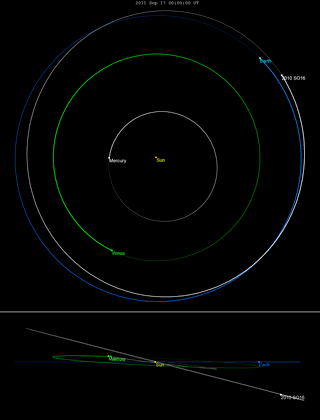(419624) 2010 SO16
 Orbit with inner solar system | |
| Discovery [1] | |
|---|---|
| Discovered by | WISE |
| Discovery site | Low Earth orbit |
| Discovery date | 17 September 2010 |
| Designations | |
| MPC designation | (419624) 2010 SO16 |
| 2010 SO16 | |
| Apollo · NEO · PHA [1][2] | |
| Orbital characteristics [1] | |
| Epoch 4 September 2017 (JD 2458000.5) | |
| Uncertainty parameter 0 | |
| Observation arc | 5.28 yr (1,928 days) |
| Aphelion | 1.0785 AU |
| Perihelion | 0.9272 AU |
| 1.0028 AU | |
| Eccentricity | 0.0754 |
| 1.00 yr (367 days) | |
| 173.30° | |
| 0° 58m 53.04s / day | |
| Inclination | 14.520° |
| 40.397° | |
| 108.99° | |
| Earth MOID | 0.0299 AU (11.6 LD) |
| Physical characteristics | |
Mean diameter | 0.357±0.126 km[3] |
| 0.084±0.057[4] | |
| 20.5[1] | |
|
| |
(419624) 2010 SO16 is a sub-kilometer asteroid in a co-orbital configuration with Earth, classified as near-Earth object and potentially hazardous asteroid of the Apollo group. It was discovered by the Wide-field Infrared Survey Explorer space telescope (WISE) on 17 September 2010.[1][2]
Description
The orbit was described by Christou Apostolos and David Asher at the Armagh Observatory in Northern Ireland.[5] The object has an absolute magnitude of 20.5.[1] Observations by the discovering WISE telescope give a diameter of 357 meters and an albedo of 0.084.[3][4]
2010 SO16 has a horseshoe orbit that allows it to stably share Earth's orbital neighborhood without colliding with it. It is one of a handful of known asteroids with an Earth-following orbit, a group that includes 3753 Cruithne, and the only known asteroid in an horseshoe orbit with Earth. It is, however, neither an Aten asteroid nor an Apollo asteroid because the semi-major axis of its orbit is neither less than nor greater than 1 AU, but oscillates between approximately 0.996 and 1.004 AU, with a period of about 350 years.[5] In its ~350 yr horseshoe cycle, it never approaches Earth more closely than about 0.15 AU, alternately trailing and leading.
According to various simulations 2010 SO16 will remain in this orbit for at least 120,000 years and possibly for more than a million years, which is unusually stable compared to other similar objects.[6] One reason for this stability is its low orbital eccentricity, .[5]
A precovery of 2010 SO16 may have been located in a 2005 Spitzer Space Telescope image.[7]
See also
- 3753 Cruithne – a horseshoe companion of the Earth
- 2006 RH120 – a small asteroid that sometimes temporarily gets caught in Earth orbit
- 2002 AA29 – a horseshoe companion of the Earth
- Natural satellite
References
- 1 2 3 4 5 6 "JPL Small-Body Database Browser: 419624 (2010 SO16)" (2015-12-28 last obs.). Jet Propulsion Laboratory. Retrieved 6 February 2018.
- 1 2 "419624 (2010 SO16)". Minor Planet Center. Retrieved 6 February 2018.
- 1 2 Nugent, C. R.; Mainzer, A.; Masiero, J.; Bauer, J.; Cutri, R. M.; Grav, T.; et al. (December 2015). "NEOWISE Reactivation Mission Year One: Preliminary Asteroid Diameters and Albedos" (PDF). The Astrophysical Journal. 814 (2): 13. arXiv:1509.02522. Bibcode:2015ApJ...814..117N. doi:10.1088/0004-637X/814/2/117. Retrieved 6 February 2018.
- 1 2 Mainzer, A.; Grav, T.; Masiero, J.; Bauer, J.; Cutri, R. M.; McMillan, R. S.; et al. (November 2012). "Physical Parameters of Asteroids Estimated from the WISE 3-Band Data and NEOWISE Post-Cryogenic Survey" (PDF). The Astrophysical Journal Letters. 760 (1): 6. arXiv:1210.0502. Bibcode:2012ApJ...760L..12M. doi:10.1088/2041-8205/760/1/L12. Retrieved 6 February 2018.
- 1 2 3 Christou, A. A.; Asher, D. J. (July 2011). "A long-lived horseshoe companion to the Earth" (PDF). Monthly Notices of the Royal Astronomical Society. 414 (4): 2965–2969. arXiv:1104.0036. Bibcode:2011MNRAS.414.2965C. doi:10.1111/j.1365-2966.2011.18595.x. Retrieved 6 February 2018.
- ↑ Asteroid Discovered in Horseshoe-Shaped Orbit, The Physics arXiv Blog, Technology Review, 4/05/2011
- ↑ "New Tool Finds Buried Treasure in Spitzer Archives". NASA/JPL. 2014-04-03. Retrieved 2014-04-25.